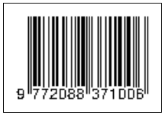Implementasi Algoritma PSO Pada Multi Mobile Robot Dalam Penentuan Posisi Target Terdekat
Ikhwannuary Raditya Priyadana(1*), Bakhtiar Alldino Ardi Sumbodo(2), Triyogatama Wahyu Widodo(3)
(1) Program Studi Elektronika dan Instrumentasi, FMIPA UGM, Yogyakarta
(2) Departemen Ilmu Komputer dan Elektronika, FMIPA UGM, Yogyakarta
(3) Departemen Ilmu Komputer dan Elektronika, FMIPA UGM, Yogyakarta
(*) Corresponding Author
Abstract
Swarm Intelligence is an artificial intelligence developed by adapting the social behavior of a group of animal. In the migratory birds community, it is known that the behavior of the birds during the flight forms a 'V' formation that plays a role in optimizing the bird's energy saving. The basic principle of a swarm intelligence is the existence of collective, decentralized and self-organizing behavior. This is the basis for the development of behavioral algorithms flocking birds called Particle Swarm Optimization (PSO).
In this research used three mobile robot as object to implement PSO algorithm. Three pieces of this robot is homogeneous, which is similar hardware and software. A group of these robots will complete the joint mission of defining the robot with the closest distance to the target TPr (robot handler). There are three TPr targets that have to be executed by the robot handler according to their position with the target point to be completed. The test is done by taking odometry data every 250 milisekon and data frame robot communication.
At the end of this research, the result of modeling system result of PSO algorithm implementation on mobile robot group to determine the robot closest to the target. The robot system that meets the principles of PSO, namely the process of data sharing and learning process.
Keywords
Full Text:
PDFReferences
[1] E. Bonabeau, M. Dorigo, and G. Theraulaz, Swarm intelligence: from natural to artificial systems, no. 1. Oxford university press, 1999.
[2] Y. Liu and K. M. Passino, “Swarm Intelligence : Literature Overview,” no. 614, 2015.
[3] J. Kennedy and R. Eberhart, “Particle swarm optimization,” 1995 IEEE Int. Conf. Neural Networks (ICNN 95), vol. 4, pp. 1942–1948, 1995.
[4] F. T. Muijres and M. H. Dickinson, “Fly with a little flap from your friends,” Nature, vol. 505, pp. 295–6, 2014.
[5] M. G. C. A. Cimino, A. Lazzeri, and G. Vaglini, “Combining stigmergic and flocking behaviors to coordinate swarms of drones performing target search,” IISA 2015 - 6th Int. Conf. Information, Intell. Syst. Appl., 2016.
[6] E. Papadopoulos and M. Misailidis, “On Differential Drive Robot Odometry with Application to Path Planning,” Control, pp. 5492–5499, 2007.
[7] R. K. Rasul, “Implementasi Sistem Gerak pada Autonomous Swarm Mobile Robot dengan Metode Odometri dan Algoritma Perilaku Semut untuk Menemukan Target,” Skripsi. Fak. MIPA,Universitas Gadjah Mada, Yogyakarta, 2013.
[8] A. Djoewahir, K. Tanaka, and S. Nakashima, “Adaptive PSO-based self-tuning PID controller for ultrasonic motor,” Int. J. Innov. Comput. Inf. Control, vol. 9, no. 10, pp. 3903–3914, 2013.
[9] H. Sa’adi, “Prototipe Robot Pengikut pada Implementasi Robot Swarm untuk Membentuk Formasi Pengikut Pemimpin.” Institut Teknologi Sepuluh Nopember, Surabaya, 2010.
[10] A. E. Turgut, C. Huepe, H. Çelikkanat, F. Gökçe, and E. Şahin, “Modeling phase transition in self-organized mobile robot flocks,” Lect. Notes Comput. Sci. (including Subser. Lect. Notes Artif. Intell. Lect. Notes Bioinformatics), vol. 5217 LNCS, pp. 108–119, 2008.
[11] K. Mukhtar and R. Sumiharto, “Konfigurasi Autonomous Routing untuk Jaringan Sensor Nirkabel Berbasis XBee,” IJEIS (Indonesian J. Electron. Instrum. Syst., vol. 2, no. 1, pp. 33–44, 2012 [Online]. Available: https://jurnal.ugm.ac.id/ijeis/article/view/2338. [Accessed: 31-May-2017]
Article Metrics
Refbacks
- There are currently no refbacks.
Copyright (c) 2018 IJEIS (Indonesian Journal of Electronics and Instrumentation Systems)

This work is licensed under a Creative Commons Attribution-ShareAlike 4.0 International License.
View My Stats1







